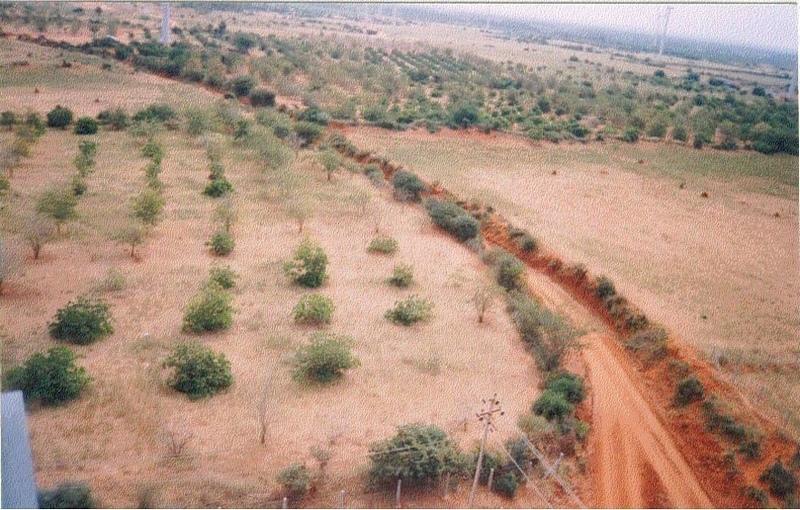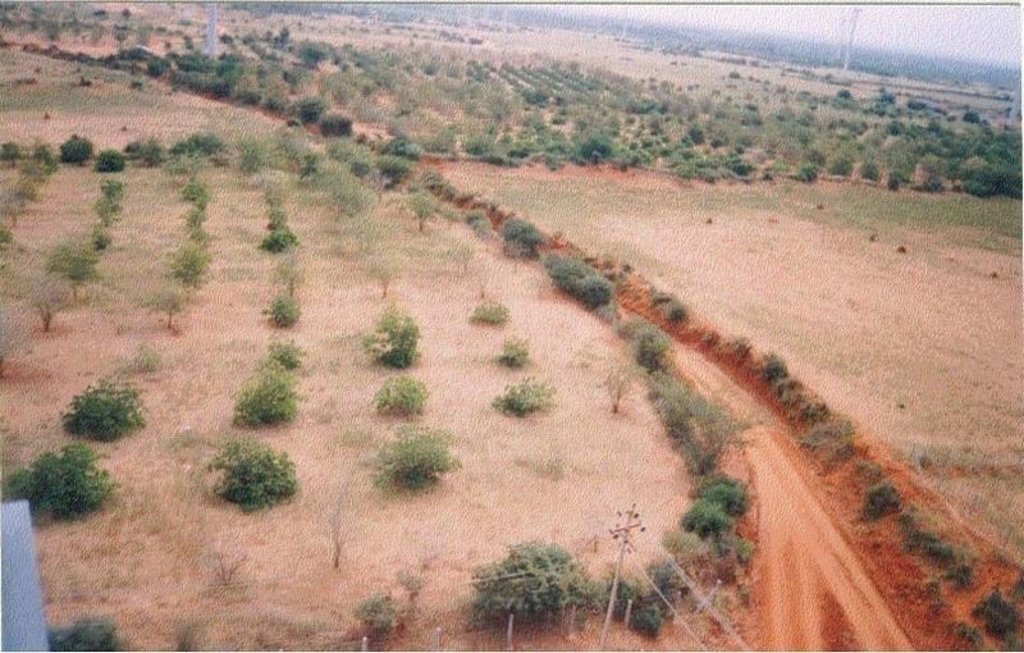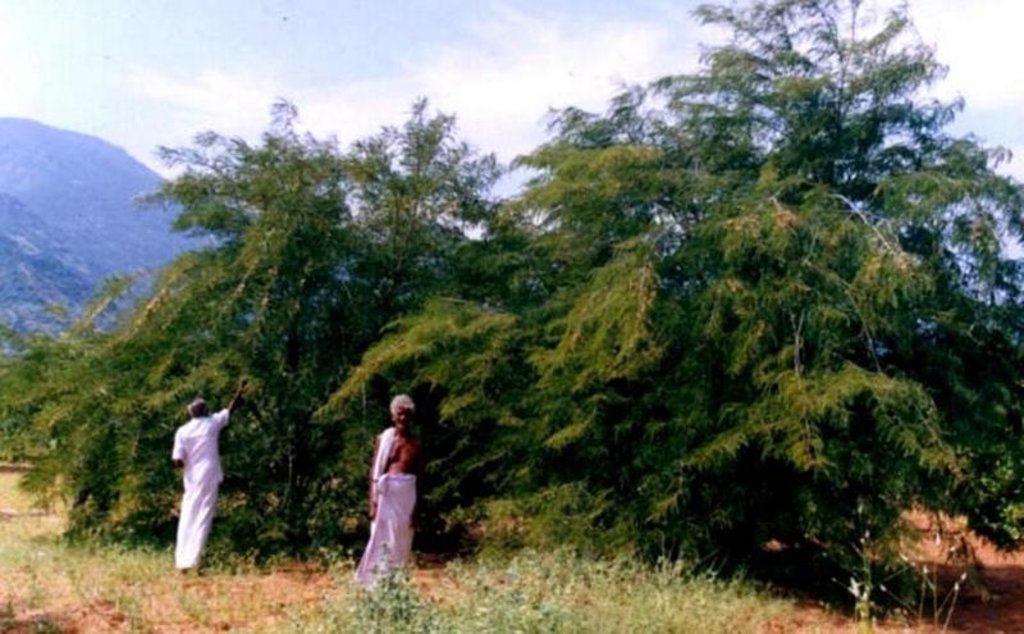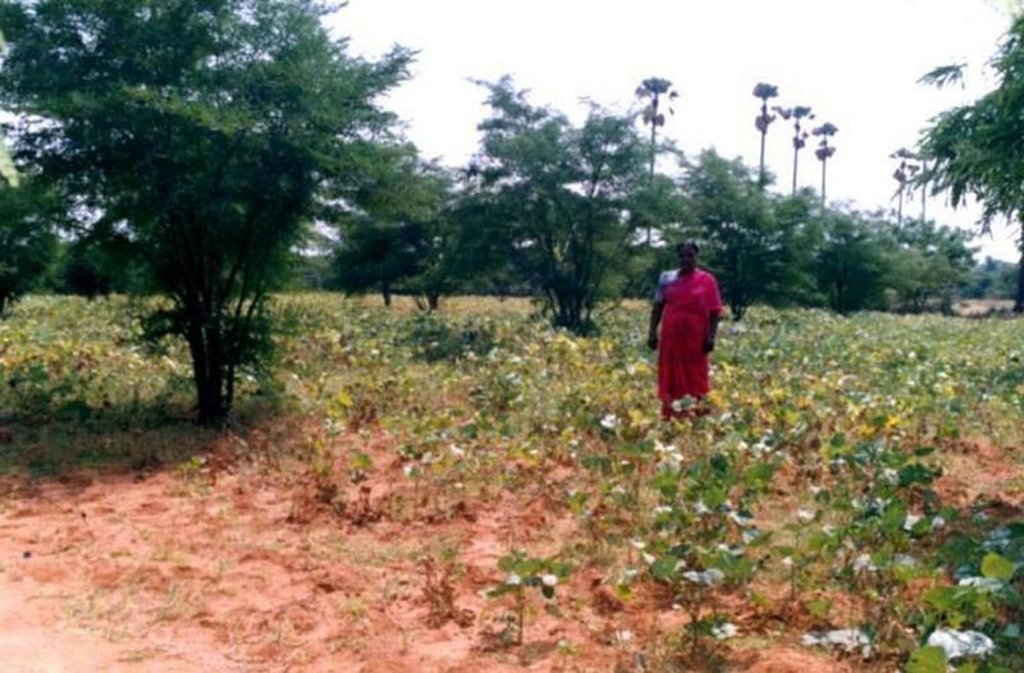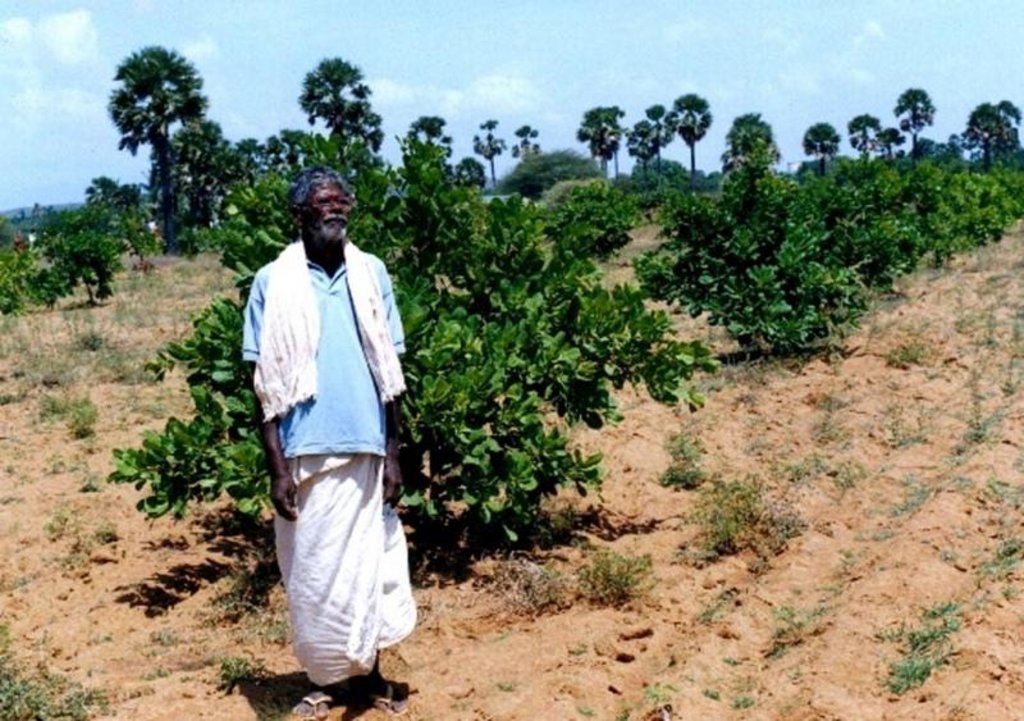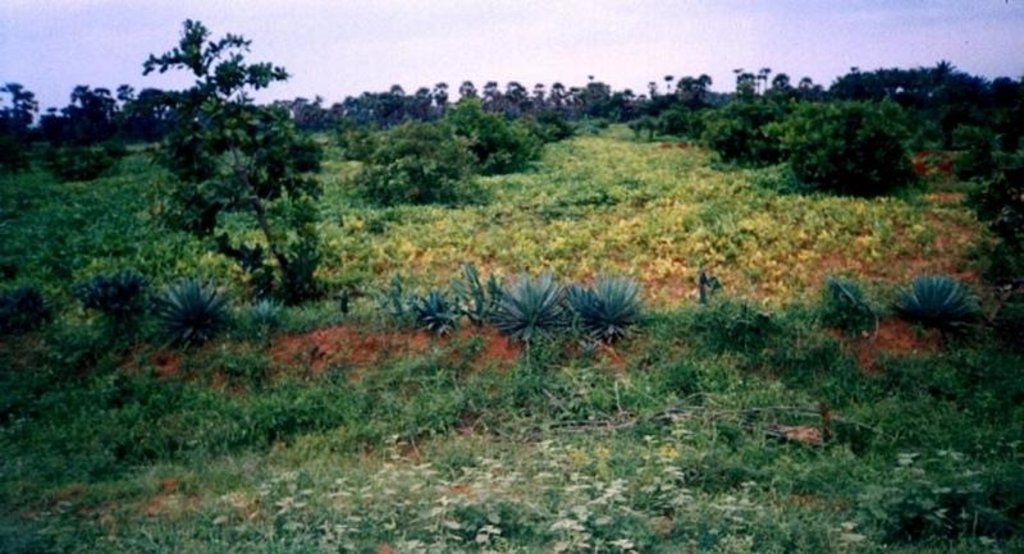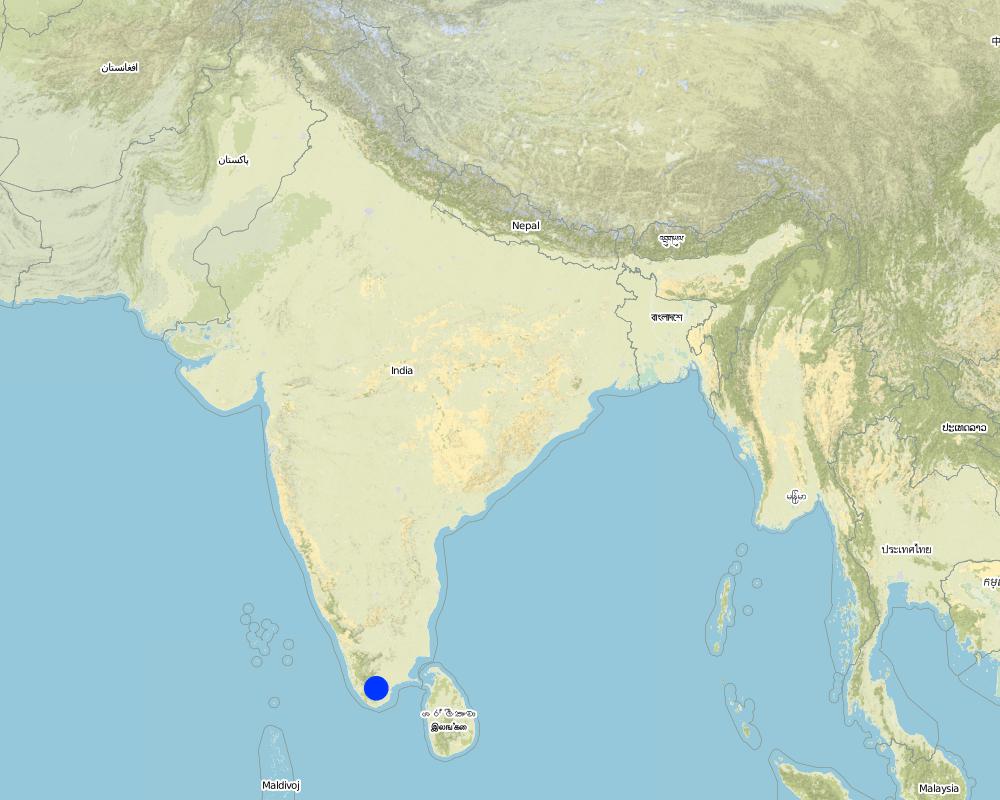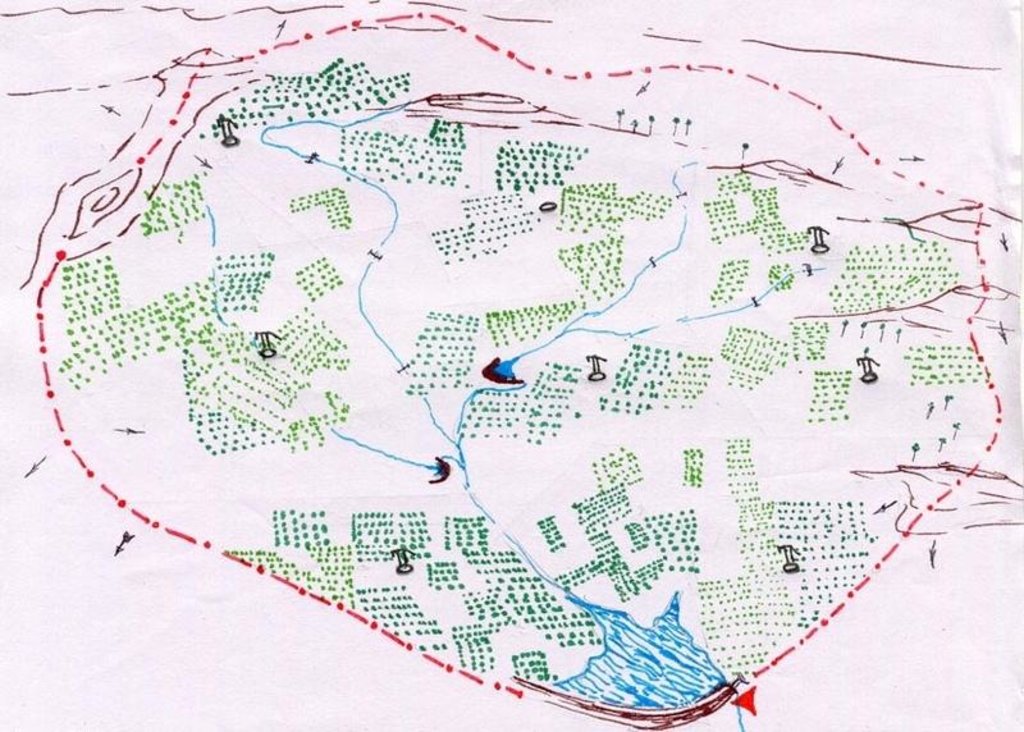Agro-forestry [ອິນເດຍ]
- ການສ້າງ:
- ປັບປູງ:
- ຜູ້ສັງລວມຂໍ້ມູນ: Unknown User
- ບັນນາທິການ: –
- ຜູ້ທົບທວນຄືນ: Fabian Ottiger, Alexandra Gavilano
Kaadu, Vilai, Thottam (Tamil)
technologies_1083 - ອິນເດຍ
ເບິ່ງພາກສ່ວນ
ຂະຫຍາຍທັງໝົດ ຍຸບທັງໝົດ1. ຂໍ້ມູນທົ່ວໄປ
1.3 ເງື່ອນໄຂ ກ່ຽວກັບ ການນໍາໃຊ້ຂໍ້ມູນເອກະສານ ທີ່ສ້າງຂື້ນ ໂດຍຜ່ານ ອົງການພາບລວມຂອງໂລກ ທາງດ້ານແນວທາງ ແລະ ເຕັກໂນໂລຢີ ຂອງການອານຸລັກ ທໍາມະຊາດ (WOCAT)
ຜູ້ປ້ອນຂໍ້ມູນ ແລະ ບຸກຄົນສຳຄັນ ທີ່ໃຫ້ຂໍ້ມູນ (ຫຼາຍ) ຍິນຍອມ ຕາມເງື່ອນໄຂ ໃນການນຳໃຊ້ຂໍ້ມູນ ເພື່ອສ້າງເປັນເອກກະສານຂອງ WOCAT:
ແມ່ນ
2. ການອະທິບາຍ ເຕັກໂນໂລຢີ ຂອງການຄຸ້ມຄອງ ທີ່ດິນແບບຍືນຍົງ
2.1 ຄໍາອະທິບາຍສັ້ນຂອງ ເຕັກໂນໂລຢີ
ການກຳໜົດຄວາມໝາຍ ຂອງເຕັກໂນໂລຢີ:
Development of degraded lands through plantation of productive tree species for long term benefit (conservation and economic) and cultivation of intercrop for short term benefit.
2.2 ການອະທິບາຍ ລາຍລະອຽດ ຂອງເຕັກໂນໂລຢີ
ການພັນລະນາ:
The technology can be described as a combination of tree cultivation ( mainly horticulture species) along with intercrop of pulse crops on degraded private lands, supported by in-situ measures for soil and water conservation. The supportive technology required is provision of water for protective irrigation during establishment phase.
Purpose of the Technology: the technology serves the folowing purposes 1. Short and long term economic benefits to land owners 2. Employment generation leading to reduced migration 3. Conservation of soil and water through vegetative and mechanical measures.
Establishment / maintenance activities and inputs: 1. Community organisation, formation of Village Development Association, Identification and training of beneficiaries 2. Delineation of micro-watersheds and plantation blocks. 3. Establishment of farmers's nurseries 4. Land preparation, sinking bore-well, plantation and inter-cropping 5. Watch and ward.
Natural / human environment: The environment is semi-arid, drought prone and subject to wind erosion. Soil depth is good.
2.3 ຮູບພາບຂອງເຕັກໂນໂລຢີ
2.5 ປະເທດ / ເຂດ / ສະຖານທີ່ບ່ອນທີ່ ເຕັກໂນໂລຢີ ໄດ້ຮັບການນໍາໃຊ້ ແລະ ທີ່ຖືກປົກຄຸມດ້ວຍການປະເມີນຜົນ
ປະເທດ:
ອິນເດຍ
ພາກພື້ນ / ລັດ / ແຂວງ:
Tamilnadu
ໃຫ້ລະບຸ ການແຜ່ຂະຫຍາຍ ເຕັກໂນໂລຢີ:
- ແຜ່ຂະຫຍາຍຢ່າງໄວວາໃນພື້ນທີ່
ຖ້າຫາກວ່າເຕັກໂນໂລຢີ ໄດ້ກະຈາຍໄປທົ່ວພື້ນທີ່, ໃຫ້ລະບຸເນື້ອທີ່ ທີ່ຖືກປົກຄຸມ (ເປັນ ກິໂລຕາແມັດ):
3.83
ຄວາມຄິດເຫັນ:
Total area covered by the SLM Technology is 3.83 km2.
The area is predominantly degraded land affected by wind erosion. The annual rainfall is <600 mm, however distribution is erratic resulting in drought conditions. People are mostly small farmers engaged in rainfed agriculture, however large areas have been abandoned due to frequent crop failure. The technology has been applied in a gross area of over 300 sq.km.
Map
×2.6 ວັນທີໃນການຈັດຕັ້ງປະຕິບັດ
ຖ້າຫາກວ່າ ບໍ່ຮູ້ຈັກ ປີທີ່ຊັດເຈນ ແມ່ນໃຫ້ປະມານ ວັນທີເອົາ:
- ຫຼາຍກ່ອນ 50 ປີຜ່ານມາ (ແບບພື້ນບ້ານ)
2.7 ການນໍາສະເໜີ ເຕັກໂນໂລຢີ
ໃຫ້ລະບຸ ເຕັກໂນໂລຢີ ໄດ້ຖືກຈັດຕັ້ງປະຕິບັດຄືແນວໃດ?
- ໂດຍຜ່ານໂຄງການ / ການຊ່ວຍເຫຼືອຈາກພາຍນອກ
ຄວາມຄິດເຫັນ (ປະເພດ ໂຄງການ ແລະ ອື່ນໆ):
The technology evolved out farmers suggestions and project experiences while implementing the shelter programme to combat wind erosion.
3. ການໃຈ້ແຍກ ເຕັກໂນໂລຢີ ໃນການຄຸ້ມຄອງ ດິນແບບຍືນຍົງ
3.1 ຈຸດປະສົງຫຼັກ (ຫຼາຍ) ຂອງເຕັກໂນໂລຢີ
- ປັບປຸງ ການຜະລິດ
- ຫຼຸດຜ່ອນ, ປ້ອງກັນ, ຟື້ນຟູ ການເຊື່ອມໂຊມຂອງດິນ
3.2 ປະເພດການນໍາໃຊ້ທີ່ດິນ ໃນປະຈຸບັນ() ທີ່ເຕັກໂນໂລຢີ ໄດ້ຖືກນໍາໃຊ້
ການນຳໃຊ້ທີ່ດິນ ປະສົມພາຍໃນພື້ນທີ່ດຽວກັນ:
ແມ່ນ
ລະບຸການນຳໃຊ້ທີ່ດິນແບບປະສົມ (ຜົນລະປູກ / ທົ່ງຫຍ້າລ້ຽງສັດ / ຕົ້ນໄມ້):
- ກະສິກໍາ-ປ່າໄມ້ ແບບປະສົມປະສານ

ດິນທີ່ປູກພືດ
- ການປູກພືດປະຈໍາປີ
- ເປັນໄມ້ຢືນຕົ້ນ ແລະ ໄມ້ພຸ່ມ ຈາກການປູກພືດ
ການປູກພືດປະຈຳປີ - ລະບຸປະເພດພືດ:
- ພືດຕະກູນຖົ່ວ ແລະ ຖົ່ວປະເພດອື່ນໆ
- ພືດຕະກູນຖົ່ວ ແລະ ຖົ່ວປະເພດອື່ນໆ
- ພືດປະເພດເມັດໃຫ້ນ້ຳມັນ-ຖົ່ວດິນ
- euphorbia sp.
ການປູກພືດທີ່ເປັນຕົ້ນໄມ້ ແລະ ໄມ້ພຸ່ມ - ລະບຸປະເພດພືດ:
- ໝາກມ່ວງຫິມະພານ
- ໝາກໄມ້, ອື່ນໆ
- ໝາກມ່ວງ, ໝາກມັງຄຸດ, ໝາກສີດາ
- Tamarandus indicus, Emblica officianalis
ຈໍານວນ ລະດູການ ປູກໃນປີໜຶ່ງ:
- 1
ລະບຸ ຊະນິດ:
Longest growing period in days: 100 Longest growing period from month to month: Oct - Jan

ປ່າໄມ້ / ປ່າ
ປະເພດຂອງຕົ້ນໄມ້:
- Azadirachta indica
- Albizia lebeck
ຄວາມຄິດເຫັນ:
Crop: agace, euphorbia sp.
Trees/ shrubs species: Azadirachta indica, Albizia lebeck
Fruit trees / shrubs species: Anacardium occidentale, Tamarandus indicus, Emblica officianalis, Mangifera incica
Other species: Phaseolus mungo, Arachis hypogea
Major land use problems (compiler’s opinion): Uncontrolled grazing on un-cultivated lands, abandonment of fields by poor farmers due to recurrent crop failure as a result of drought.
Major land use problems (land users’ perception): Crop lands are not economocal to cultivate due to recurrent crop failure as a result of drought. This has lead to abandonment of fields and increase in numbers of small livestock which are left free to graze.
Type of cropping system and major crops comments: The area is single cropped and hence only one food crop is taken per year.
3.4 ການສະໜອງນ້ຳ
ການສະໜອງນໍ້າ ໃນພື້ນທີ່ ທີ່ໄດ້ນໍາໃຊ້ ເຕັກໂນໂລຢີ:
- ປະສົມປະສານ ກັນລະຫວ່າງ ນໍ້າຝົນ ແລະ ນໍ້າຊົນລະປະທານ
3.5 ການນໍາໃຊ້ເຕັກໂນໂລຢີ ທີ່ຢູ່ໃນກຸ່ມການຄຸ້ມຄອງ ທີ່ດິນແບບຍືນຍົງ
- ກະສິກໍາ-ປ່າໄມ້ ແບບປະສົມປະສານ
3.6 ມາດຕະການ ການຄຸ້ມຄອງ ທີ່ດິນແບບຍືນຍົງ ປະກອບດ້ວຍ ເຕັກໂນໂລຢີ

ມາດຕະການ ທາງການກະສິກໍາ
ຄວາມຄິດເຫັນ:
Type of agronomic measures: better crop cover, mixed cropping / intercropping, mulching, pits, deep tillage / double digging
3.7 ປະເພດດິນເຊື່ອມໂຊມ ຫຼັກທີ່ໄດ້ນໍາໃຊ້ ເຕັກໂນໂລຢີ

ດິນເຊາະເຈື່ອນ ໂດຍນໍ້າ
- Wt: ການສູນເສຍຊັ້ນໜ້າດິນ / ການເຊາະເຈື່ອນຜິວໜ້າດິນ
- Wg: ການເຊາະເຈື່ອນຮ່ອງນ້ຳ / ຫ້ວຍ

ດິນເຊາະເຈື່ອນ ໂດຍລົມ
- ການສູນເສຍຊັ້ນໜ້າດິນ
ຄວາມຄິດເຫັນ:
Main type of degradation addressed: Et: loss of topsoil
Secondary types of degradation addressed: Wt: loss of topsoil / surface erosion, Wg: gully erosion / gullying
4. ຂໍ້ກໍາໜົດ, ກິດຈະກໍາການປະຕິບັດ, ວັດຖຸດິບ, ແລະຄ່າໃຊ້ຈ່າຍ
4.1 ເຕັກນິກ ໃນການແຕ້ມແຜນວາດ ເຕັກໂນໂລຢີ
ຄຸນລັກສະນະ ຂອງເຕັກນິກ (ທີ່ກ່ຽວຂ້ອງ ກັບການແຕ້ມແຜນວາດ ທາງດ້ານເຕັກນີກ):
Technical Drawing Agro-forestry
Technical knowledge required for field staff / advisors: high
Technical knowledge required for land users: moderate
Main technical functions: improvement of ground cover
Secondary technical functions: control of raindrop splash, reduction in wind speed
Better crop cover
Material/ species: trees + legume crops
Quantity/ density: 125 trees/
Remarks: Block plantation/ intercorp
Mixed cropping / intercropping
Material/ species: trees + legume crops
Quantity/ density: 125 trees/
Remarks: Block plantation/ intercorp
Mulching
Material/ species: soil mulch
Quantity/ density: 125 basins
Remarks: 1 m. diameter basin per tree
Agronomic measure: vegetative hedges
Material/ species: agace, euphorbia sp.
Quantity/ density: 15 cm. Spa
Remarks: Along field boundries
Pits
Remarks: 125 pits/ha., 9 m. spacing. 45*45*45 cm for local species & 60*60*60 cm for grafts.
Deep tillage / double digging
Remarks: disc ploughing before pitting in first year, tiller ploughing annually at sowing of intercorp..
Trees/ shrubs species: Azadirachta indica, Albizia lebeck
Fruit trees / shrubs species: Anacardium occidentale, Tamarandus indicus, Emblica officianalis, Mangifera incica
Other species: Phaseolus mungo, Arachis hypogea
Slope (which determines the spacing indicated above): 3.00%
Change of land use type: open grazing, cropping to agro-forestry
Change of land use practices / intensity level: open access to protected
Layout change according to natural and human environment: borewell blocks formed as per human environment but within watershed boundary.
Control / change of species composition: scrub clearance followed by plantation of agro-horticulture species.
Other type of management: VDA established - to manage all activities at village level
ຜູ້ຂຽນ:
D. Samraj, Tiruneveli, Tamilna
4.2 ຂໍ້ມູນທົ່ວໄປກ່ຽວກັບການຄິດໄລ່ປັດໃຈຂາເຂົ້າໃນການຜະລິດ ແລະ ມູນຄ່າອື່ນໆ
ສະກຸນເງິນອື່ນໆ / ປະເທດອື່ນໆ (ລະບຸ):
Indian Rupee
ຖ້າກ່ຽວຂ້ອງ, ໃຫ້ລະບຸອັດຕາແລກປ່ຽນຈາກ USD ເປັນສະກຸນເງິນທ້ອງຖິ່ນ (ເຊັ່ນ: 1 USD = 79.9 Brazilian Real): 1 USD =:
48.85
ລະບຸ ຄ່າຈ້າງ ຄ່າແຮງງານສະເລ່ຍ ຕໍ່ ວັນ:
1.00
4.3 ການສ້າງຕັ້ງກິດຈະກໍາ
| ກິດຈະກໍາ | Timing (season) | |
|---|---|---|
| 1. | Nursery raising | May - Nov |
| 2. | Planting in pits | Oct -Dec, onset of monsoon |
| 3. | Life watering | immediately after plantation |
| 4. | Planting of vegetative hedges | Oct - Dec |
| 5. | Sowing of intercrop (broadcasting, dibbling) | Premonsoon-groundnut, monsoon-legumes |
| 6. | Application of FYM to intercrop | September during tiller ploughing |
| 7. | Selection of village as per criteria | Mar/Apr, dry season |
| 8. | Rapport building, awareness generation | |
| 9. | VDA formation | April / May |
| 10. | Development of watershed plan including agroforestry | May / June |
| 11. | Trainings for VDA, farmers, nursery etc. | Jun - Aug |
4.4 ຕົ້ນທຶນ ແລະ ປັດໄຈຂາເຂົ້າທີ່ຈໍາເປັນໃນຈັດຕັ້ງປະຕິບັດ
ຄວາມຄິດເຫັນ:
Duration of establishment phase: 24 month(s)
4.5 ບໍາລຸງຮັກສາ / ແຜນຈັດຕັ້ງປະຕິບັດ ກິດຈະກໍາ
| ກິດຈະກໍາ | ໄລຍະເວລາ / ຄວາມຖີ່ | |
|---|---|---|
| 1. | scrub clearance | Sept/Oct,dry season / once before planting |
| 2. | deep ploughing | Oct/Nov,onset of monsoon / once before planting |
| 3. | pitting | Oct/Nov / once before planting |
| 4. | manuring | Oct/Nov / once before planting |
| 5. | filling pits, planting, forming basins | Nov / once before planting |
| 6. | life watering | Nov / after planting |
| 7. | tiller ploughing & sowing | Oct/Nov / annually after onset of monsoon |
| 8. | maintenance of tree basins | Oct / after annual tiller ploughing |
| 9. | Periodical watering | dry months 1st year /weekly |
| 10. | Weed removal | Nov / Dec /once during annual crop |
| 11. | Application of pesticides | Dec - Feb /as necessary |
| 12. | Pruning | Nov /annually |
| 13. | Casualty replacement | Nov /One year after plantation |
| 14. | Monitoring by VDA | - / monthly |
| 15. | Hand pump maintenance | / as required |
| 16. | Protection against animals | Year one / full time |
4.6 ຄ່າໃຊ້ຈ່າຍ ແລະ ປັດໄຈນໍາເຂົ້າທີ່ຈໍາເປັນສໍາລັບການບໍາລຸງຮັກສາກິດຈະກໍາ / ແຜນປະຕິບັດ (ຕໍ່ປີ)
ຄວາມຄິດເຫັນ:
- The costs were calculated for establishment of one block (average area 12.5 ha.) of horticulture plantation with project support. The agriculture component was implemented by farmer with project support for seeds during first monsoon and tiller ploughing during second monsoon.
4.7 ປັດໄຈ ທີ່ສໍາຄັນ ທີ່ສົ່ງຜົນກະທົບ ຕໍ່ຄ່າໃຊ້ຈ່າຍ
ໃຫ້ອະທິບາຍ ປັດໃຈ ທີ່ສົ່ງຜົນກະທົບ ຕໍ່ຕົ້ນທຶນ ໃນການຈັດຕັ້ງປະຕິບັດ:
- Establishment of the technology requires high labor input, specially for watering and watch & ward, which adds significantly to the cost. - Presence of hard pan necessiates deep ploughing with machinery. - Horticulture tree species were selected over forest species.
5. ສະພາບແວດລ້ອມທໍາມະຊາດ ແລະ ມະນຸດ
5.1 ອາກາດ
ປະລິມານນໍ້າຝົນປະຈໍາປີ
- < 250 ມີລິແມັດ
- 251-500 ມີລິແມັດ
- 501-750 ມີລິແມັດ
- 751-1,000 ມີລິແມັດ
- 1,001-1,500 ມີລິແມັດ
- 1,501-2,000 ມີລິແມັດ
- 2,001-3,000 ມີລິແມັດ
- 3,001-4,000 ມີລິແມັດ
- > 4,000 ມີລິແມັດ
ຂໍ້ມູນສະເພາະ / ຄວາມເຫັນກ່ຽວກັບ ປະລິມານນໍ້າຝົນ:
680 mm, however the rainfall over the past few years has been < 500 mm.
ເຂດສະພາບອາກາດກະສິກໍາ
- ເຄິ່ງແຫ້ງແລ້ງ
Since past few years arid conditions prevail in the area
5.2 ພູມິປະເທດ
ຄ່າສະເລ່ຍ ຄວາມຄ້ອຍຊັນ:
- ພື້ນທີ່ຮາບພຽງ (0-2%)
- ອ່ອນ (3-5 %)
- ປານກາງ (6-10 %)
- ມ້ວນ (11-15 %)
- ເນີນ(16-30%)
- ໍຊັນ (31-60%)
- ຊັນຫຼາຍ (>60%)
ຮູບແບບຂອງດິນ:
- ພູພຽງ / ທົ່ງພຽງ
- ສັນພູ
- ເປີ້ນພູ
- ເນີນພູ
- ຕີນພູ
- ຮ່ອມພູ
ເຂດລະດັບສູງ:
- 0-100 ແມັດ a.s.l.
- 101-500 ແມັດ a.s.l.
- 501-1,000 ແມັດ a.s.l.
- 1,001-1,500 ແມັດ a.s.l.
- 1,501-2,000 ແມັດ a.s.l.
- 2,001-2,500 ແມັດ a.s.l.
- 2,501-3,000 ແມັດ a.s.l.
- 3,001-4,000 ແມັດ a.s.l.
- > 4,000 ແມັດ a.s.l.
ຄຳເຫັນ ແລະ ຂໍ້ມູນສະເພາະ ເພີ່ມເຕີມ ກ່ຽວກັບ ພູມີປະເທດ:
Landforms: Plateau/plains (level lands lying between hill slopes of Western mountain range & East coast of south India.)
Slopes on average: Flat (level land with some gullies passing through (originating in upper hilly area))
5.3 ດິນ
ຄວາມເລິກ ຂອງດິນສະເລ່ຍ:
- ຕື້ນຫຼາຍ (0-20 ຊັງຕີແມັດ)
- ຕື້ນ (21-50 ຊຕມ)
- ເລີກປານກາງ (51-80 ຊຕມ)
- ເລິກ (81-120 ຊມ)
- ເລິກຫຼາຍ (> 120 cm)
ເນື້ອດິນ (ໜ້າດິນ):
- ປານກາງ (ດິນໜຽວ, ດິນໂຄນ)
ຊັ້ນອິນຊີວັດຖຸ ເທິງໜ້າດິນ:
- ປານກາງ (1-3 %)
ຖ້າເປັນໄປໄດ້ ແມ່ນໃຫ້ຕິດຄັດ ການພັນລະນາດິນ ຫຼື ຂໍ້ມູນສະເພາະຂອງດິນ, ຕົວຢ່າງ, ຄຸນລັກສະນະ ປະເພດຂອງດິນ, ຄ່າຄວາມເປັນກົດ / ເປັນດ່າງຂອງດິນ, ສານອາຫານ, ດິນເຄັມ ແລະ ອື່ນໆ.
Soil depth on average: Moderately deep (ranked 1) and deep (ranked 2, patches of deep soil)
Soil texture: Medium (sandy loam)
Soil fertility: Medium (loss of top soil due to erosion)
Topsoil organic matter: Medium (originally low before agro-forestry)
Soil drainage/infiltration level: Medium (presence of hardpan below six inch depth. However, no waterlogging is observed due to runoff.)
Soil water storage capacity: Medium (has improved due to deep ploughing post treatment)
5.6 ຄຸນລັກສະນະ ຂອງຜູ້ນໍາໃຊ້ທີ່ດິນ ທີ່ໄດ້ນໍາໃຊ້ເຕັກໂນໂລຢີ
ລາຍຮັບ ທີ່ບໍ່ໄດ້ມາຈາກ ການຜະລິດ ກະສິກໍາ:
- 10-50 % ຂອງລາຍຮັບທັງໝົດ
ລະດັບຄວາມຮັ່ງມີ:
- ທຸກຍາກ
- ສະເລ່ຍ
ໃຫ້ລະບຸ ຄຸນລັກສະນະ ຂອງຜູ້ນໍາໃຊ້ທີ່ດິນ:
Population density: 100-200 persons/km2
Annual population growth: 1% - 2%
11% of the land users are rich and own 18% of the land (large holdings > 2 ha.).
50% of the land users are average wealthy and own 56% of the land (holdings of 1 to 2 ha.).
39% of the land users are poor and own 26% of the land (holdings < 1 ha.).
Off-farm income specification: Off farm sources are; poor - rolling beedis (locally made cigarettes), daily wage labor in fields and brick kilns. Average / rich; Business, livestock.
Level of mechanization: Manual labour (ranked 1, pitting, planting, watering, cultivating, watch and ward), mechanised (ranked 2, deep ploughing, tiller ploughing, drilling borewell) and animal traction (ranked 3, ploughing)
5.8 ເຈົ້າຂອງທີ່ດິນ, ສິດໃຊ້ທີ່ດິນ, ແລະ ສິດທິການນໍາໃຊ້ນໍ້າ
ເຈົ້າຂອງດິນ:
- ບຸກຄົນ, ທີ່ມີຕໍາແໜ່ງ
ສິດທິ ໃນການນໍາໃຊ້ທີ່ດິນ:
- ບຸກຄົນ
6. ຜົນກະທົບ ແລະ ລາຍງານສະຫຼຸບ
6.4 ການວິເຄາະຕົ້ນທຶນ ແລະ ຜົນປະໂຫຍດ
ຈະເຮັດປະໂຫຍດເພື່ອປຽບທຽບກັບຄ່າໃຊ້ຈ່າຍກັບສິ່ງກໍ່ສ້າງ (ຈາກທັດສະນະຂອງຜູ້ນຳໃຊ້ທີ່ດິນ) ໄດ້ແນວໃດ?
ຜົນຕອບແທນ ໃນໄລຍະສັ້ນ:
ຜົນກະທົບທາງລົບເລັກນ້ອຍ
ຜົນຕອບແທນ ໃນໄລຍະຍາວ:
ຜົນກະທົບທາງບວກ
ຈະໄດ້ຮັບຜົນປະໂຫຍດເມື່ອປຽບທຽບກັບ / ຄ່າໃຊ້ຈ່າຍໃນການບຳລຸງຮັກສາທີເ່ກີດຂື້ນອິກ (ຈາກທັດສະນະຄະຕິຂອງຜູ້ນຳໃຊ້ທີ່ດິນ) ໄດ້ແນວໃດ?
ຜົນຕອບແທນ ໃນໄລຍະສັ້ນ:
ຜົນກະທົບທາງລົບເລັກນ້ອຍ
ຜົນຕອບແທນ ໃນໄລຍະຍາວ:
ຜົນກະທົບທາງບວກຫຼາຍ
6.5 ການປັບຕົວຮັບເອົາເຕັກໂນໂລຢີ
ຄວາມຄິດເຫັນ:
99% of land user families have adopted the Technology with external material support
284 land user families have adopted the Technology with external material support
Comments on acceptance with external material support: estimates
1% of land user families have adopted the Technology without any external material support
2 land user families have adopted the Technology without any external material support
Comments on spontaneous adoption: estimates
There is a little trend towards spontaneous adoption of the Technology
Comments on adoption trend: Farmers are purchasing seedlings for plantation on their fields in small patches around existing water sources - Farmers who did not participate initially are now expressing a desire to treat their lands under the project.
7. ເອກະສານອ້າງອີງ ແລະ ການເຊື່ອມຕໍ່
7.1 ວິທີການ / ແຫຼ່ງຂໍ້ມູນ
7.2 ເອກກະສານອ້າງອີງທີ່ເປັນບົດລາຍງານ
ຫົວຂໍ້, ຜູ້ຂຽນ, ປີ, ISBN:
Review reports.
ມີຢູ່ໃສ?ມູນຄ່າເທົ່າໃດ?
Chief Engineer, Agriculture Engineering Department, Anna Salai-439, Nandanam, Chennai-600035
ຫົວຂໍ້, ຜູ້ຂຽນ, ປີ, ISBN:
Project Implementation Plan. 2001.
ມີຢູ່ໃສ?ມູນຄ່າເທົ່າໃດ?
Programme Coordinator, WDCU, 11/1 Sarvapriya Vihar, New Delhi-110016.
ຫົວຂໍ້, ຜູ້ຂຽນ, ປີ, ISBN:
Participatory Impact Evaluation. 2001.
ຂໍ້ມູນການເຊື່ອມຕໍ່ ແລະ ເນື້ອໃນ
ຂະຫຍາຍທັງໝົດ ຍຸບທັງໝົດການເຊື່ອມຕໍ່
ບໍ່ມີຂໍ້ມູນການເຊື່ອມຕໍ່
ເນື້ອໃນ
ບໍ່ມີເນື້ອໃນ


